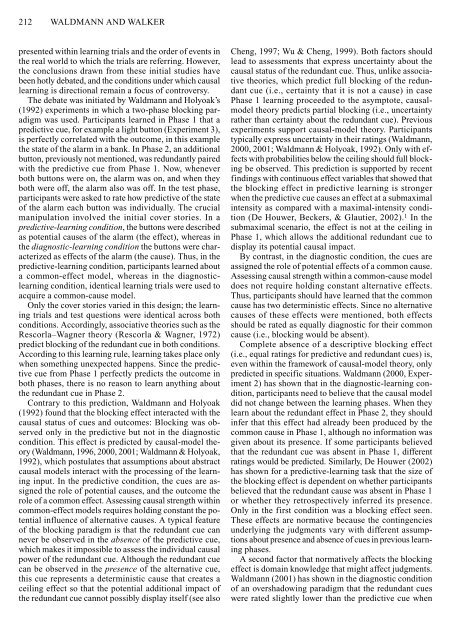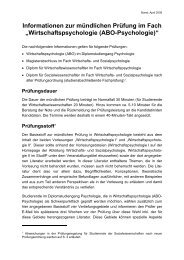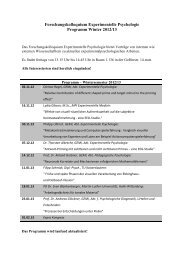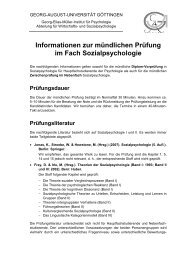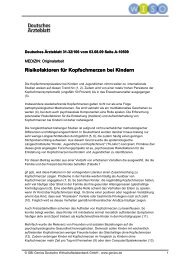Competence and performance in causal learning
Competence and performance in causal learning
Competence and performance in causal learning
You also want an ePaper? Increase the reach of your titles
YUMPU automatically turns print PDFs into web optimized ePapers that Google loves.
212 WALDMANN AND WALKER<br />
presented with<strong>in</strong> learn<strong>in</strong>g trials <strong>and</strong> the order of events <strong>in</strong><br />
the real world to which the trials are referr<strong>in</strong>g. However,<br />
the conclusions drawn from these <strong>in</strong>itial studies have<br />
been hotly debated, <strong>and</strong> the conditions under which <strong>causal</strong><br />
learn<strong>in</strong>g is directional rema<strong>in</strong> a focus of controversy.<br />
The debate was <strong>in</strong>itiated by Waldmann <strong>and</strong> Holyoak’s<br />
(1992) experiments <strong>in</strong> which a two-phase block<strong>in</strong>g paradigm<br />
was used. Participants learned <strong>in</strong> Phase 1 that a<br />
predictive cue, for example a light button (Experiment 3),<br />
is perfectly correlated with the outcome, <strong>in</strong> this example<br />
the state of the alarm <strong>in</strong> a bank. In Phase 2, an additional<br />
button, previously not mentioned, was redundantly paired<br />
with the predictive cue from Phase 1. Now, whenever<br />
both buttons were on, the alarm was on, <strong>and</strong> when they<br />
both were off, the alarm also was off. In the test phase,<br />
participants were asked to rate how predictive of the state<br />
of the alarm each button was <strong>in</strong>dividually. The crucial<br />
manipulation <strong>in</strong>volved the <strong>in</strong>itial cover stories. In a<br />
predictive-learn<strong>in</strong>g condition, the buttons were described<br />
as potential causes of the alarm (the effect), whereas <strong>in</strong><br />
the diagnostic-learn<strong>in</strong>g condition the buttons were characterized<br />
as effects of the alarm (the cause). Thus, <strong>in</strong> the<br />
predictive-learn<strong>in</strong>g condition, participants learned about<br />
a common-effect model, whereas <strong>in</strong> the diagnosticlearn<strong>in</strong>g<br />
condition, identical learn<strong>in</strong>g trials were used to<br />
acquire a common-cause model.<br />
Only the cover stories varied <strong>in</strong> this design; the learn<strong>in</strong>g<br />
trials <strong>and</strong> test questions were identical across both<br />
conditions. Accord<strong>in</strong>gly, associative theories such as the<br />
Rescorla–Wagner theory (Rescorla & Wagner, 1972)<br />
predict block<strong>in</strong>g of the redundant cue <strong>in</strong> both conditions.<br />
Accord<strong>in</strong>g to this learn<strong>in</strong>g rule, learn<strong>in</strong>g takes place only<br />
when someth<strong>in</strong>g unexpected happens. S<strong>in</strong>ce the predictive<br />
cue from Phase 1 perfectly predicts the outcome <strong>in</strong><br />
both phases, there is no reason to learn anyth<strong>in</strong>g about<br />
the redundant cue <strong>in</strong> Phase 2.<br />
Contrary to this prediction, Waldmann <strong>and</strong> Holyoak<br />
(1992) found that the block<strong>in</strong>g effect <strong>in</strong>teracted with the<br />
<strong>causal</strong> status of cues <strong>and</strong> outcomes: Block<strong>in</strong>g was observed<br />
only <strong>in</strong> the predictive but not <strong>in</strong> the diagnostic<br />
condition. This effect is predicted by <strong>causal</strong>-model theory<br />
(Waldmann, 1996, 2000, 2001; Waldmann & Holyoak,<br />
1992), which postulates that assumptions about abstract<br />
<strong>causal</strong> models <strong>in</strong>teract with the process<strong>in</strong>g of the learn<strong>in</strong>g<br />
<strong>in</strong>put. In the predictive condition, the cues are assigned<br />
the role of potential causes, <strong>and</strong> the outcome the<br />
role of a common effect. Assess<strong>in</strong>g <strong>causal</strong> strength with<strong>in</strong><br />
common-effect models requires hold<strong>in</strong>g constant the potential<br />
<strong>in</strong>fluence of alternative causes. A typical feature<br />
of the block<strong>in</strong>g paradigm is that the redundant cue can<br />
never be observed <strong>in</strong> the absence of the predictive cue,<br />
which makes it impossible to assess the <strong>in</strong>dividual <strong>causal</strong><br />
power of the redundant cue. Although the redundant cue<br />
can be observed <strong>in</strong> the presence of the alternative cue,<br />
this cue represents a determ<strong>in</strong>istic cause that creates a<br />
ceil<strong>in</strong>g effect so that the potential additional impact of<br />
the redundant cue cannot possibly display itself (see also<br />
Cheng, 1997; Wu & Cheng, 1999). Both factors should<br />
lead to assessments that express uncerta<strong>in</strong>ty about the<br />
<strong>causal</strong> status of the redundant cue. Thus, unlike associative<br />
theories, which predict full block<strong>in</strong>g of the redundant<br />
cue (i.e., certa<strong>in</strong>ty that it is not a cause) <strong>in</strong> case<br />
Phase 1 learn<strong>in</strong>g proceeded to the asymptote, <strong>causal</strong>model<br />
theory predicts partial block<strong>in</strong>g (i.e., uncerta<strong>in</strong>ty<br />
rather than certa<strong>in</strong>ty about the redundant cue). Previous<br />
experiments support <strong>causal</strong>-model theory. Participants<br />
typically express uncerta<strong>in</strong>ty <strong>in</strong> their rat<strong>in</strong>gs (Waldmann,<br />
2000, 2001; Waldmann & Holyoak, 1992). Only with effects<br />
with probabilities below the ceil<strong>in</strong>g should full block<strong>in</strong>g<br />
be observed. This prediction is supported by recent<br />
f<strong>in</strong>d<strong>in</strong>gs with cont<strong>in</strong>uous effect variables that showed that<br />
the block<strong>in</strong>g effect <strong>in</strong> predictive learn<strong>in</strong>g is stronger<br />
when the predictive cue causes an effect at a submaximal<br />
<strong>in</strong>tensity as compared with a maximal-<strong>in</strong>tensity condition<br />
(De Houwer, Beckers, & Glautier, 2002). 1 In the<br />
submaximal scenario, the effect is not at the ceil<strong>in</strong>g <strong>in</strong><br />
Phase 1, which allows the additional redundant cue to<br />
display its potential <strong>causal</strong> impact.<br />
By contrast, <strong>in</strong> the diagnostic condition, the cues are<br />
assigned the role of potential effects of a common cause.<br />
Assess<strong>in</strong>g <strong>causal</strong> strength with<strong>in</strong> a common-cause model<br />
does not require hold<strong>in</strong>g constant alternative effects.<br />
Thus, participants should have learned that the common<br />
cause has two determ<strong>in</strong>istic effects. S<strong>in</strong>ce no alternative<br />
causes of these effects were mentioned, both effects<br />
should be rated as equally diagnostic for their common<br />
cause (i.e., block<strong>in</strong>g would be absent).<br />
Complete absence of a descriptive block<strong>in</strong>g effect<br />
(i.e., equal rat<strong>in</strong>gs for predictive <strong>and</strong> redundant cues) is,<br />
even with<strong>in</strong> the framework of <strong>causal</strong>-model theory, only<br />
predicted <strong>in</strong> specific situations. Waldmann (2000, Experiment<br />
2) has shown that <strong>in</strong> the diagnostic-learn<strong>in</strong>g condition,<br />
participants need to believe that the <strong>causal</strong> model<br />
did not change between the learn<strong>in</strong>g phases. When they<br />
learn about the redundant effect <strong>in</strong> Phase 2, they should<br />
<strong>in</strong>fer that this effect had already been produced by the<br />
common cause <strong>in</strong> Phase 1, although no <strong>in</strong>formation was<br />
given about its presence. If some participants believed<br />
that the redundant cue was absent <strong>in</strong> Phase 1, different<br />
rat<strong>in</strong>gs would be predicted. Similarly, De Houwer (2002)<br />
has shown for a predictive-learn<strong>in</strong>g task that the size of<br />
the block<strong>in</strong>g effect is dependent on whether participants<br />
believed that the redundant cause was absent <strong>in</strong> Phase 1<br />
or whether they retrospectively <strong>in</strong>ferred its presence.<br />
Only <strong>in</strong> the first condition was a block<strong>in</strong>g effect seen.<br />
These effects are normative because the cont<strong>in</strong>gencies<br />
underly<strong>in</strong>g the judgments vary with different assumptions<br />
about presence <strong>and</strong> absence of cues <strong>in</strong> previous learn<strong>in</strong>g<br />
phases.<br />
A second factor that normatively affects the block<strong>in</strong>g<br />
effect is doma<strong>in</strong> knowledge that might affect judgments.<br />
Waldmann (2001) has shown <strong>in</strong> the diagnostic condition<br />
of an overshadow<strong>in</strong>g paradigm that the redundant cues<br />
were rated slightly lower than the predictive cue when


